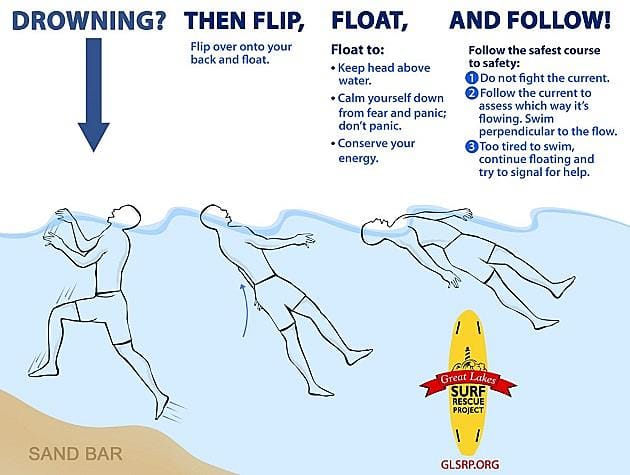We’ve all heard of “Stop, Drop and Roll” as a fire safety technique. In the Great Lake State, it’s important for residents and visitors to know “Flip, Float, and Follow” as a drowning survival strategy.
“As long as you are floating, you are alive and buying time for rescue to arrive,” said David Benjamin, executive director of the Great Lakes Surf Rescue Project.
Like “Stop, Drop, and Roll”, a simple fire safety technique taught to children as a component of fire safety week to extinguish a fire on a person’s clothes or hair, “Flip, Float and Follow” can be an effective psychological tool to focus on in order to avoid panic in a terrifying situation.
“The old rip current survival strategy, ‘Don’t panic swim parallel to shore’, may not always work,” Benjamin added. “‘Don’t panic’ is important to know but it is not a helpful action to take to alleviate panic, and swimming parallel may not always work because longshore currents run parallel to shore and structural currents run parallel to the structures (piers and jetty walls). It’s best to assess which way the current is pulling you before your risk swimming against it.”
“Flip, Float, and Follow,” is a campaign to help people remember how to successfully escape a variety of drowning accidents including dangerous currents such as rip currents, long-shore currents, and structural currents.

How to use the “Flip, Float, Follow” Drowning Survival Strategy – If you are ever caught in water over your head or a Dangerous Current:
1. FLIP:
Flip over onto your back and float.
2. FLOAT:
A. Float to keep your head above water.
B. Float to calm yourself down from the panic and fear of drowning.
C. Float to conserve your energy.
3. FOLLOW:
A. Follow the safest path to safety / out of the water.
B. Do not fight the current.
C. If you are too tired to swim, continue to float and signal for help.
Never swim against a current. If you are in a Dangerous Current, assess which way it is pulling you. Then swim perpendicular to the currents flow until you are out of it and then swim toward shore. If you are too tired to swim to shore, continue to float and signal someone on shore for help. Also, the waves may eventually bring you back to shore.
—
Content and graphic courtesy of the Great Lakes Surf Rescue Project